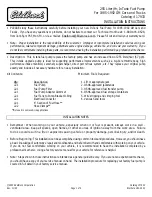
3. If you do not see steam or
spray, leave the engine running
and watch the temperature
gauge. If the high heat is due
to overloading (climbing a
long, steep hill on a hot day
with the A/C running, for
example), the engine should
start to cool down almost
immediately. If it does, wait
until the temperature gauge
comes down to the midpoint,
and then continue driving.
4. If the temperature gauge
stays at the red mark, turn off
the engine.
5. Wait until you see no more
signs of steam or spray; then
open the hood.
6. Look for any obvious coolant
leaks, such as a split radiator
hose. Everything is still
extremely hot, so use caution.
If you find a leak, it must
be repaired before you
continue driving (see
Towing
on page
188
).
7. If you don't find an obvious
leak, check the coolant level
in the radiator reserve tank
(see page
91
). If the level is
below the MIN mark, add
coolant to halfway between
the MIN and MAX marks.
8. If there was no coolant in
the reserve tank, you may
also have to add coolant to
the radiator.
Let the engine cool down
until the pointer reaches the
middle of the temperature
gauge, or lower, before
checking the radiator.
9. Using gloves or a large heavy
cloth, turn the radiator cap
counterclockwise, without
pushing down, to the first
stop. This releases any
remaining pressure in the
cooling system. After the
pressure releases, push down
on the cap and turn it until it
comes off.
Taking Care of the Unexpected
Removing the radiator cap
while the engine is hot can
cause the coolant to spray
out, seriously scalding you.
Always let the engine and
radiator cool down before
removing the radiator cap.
















































